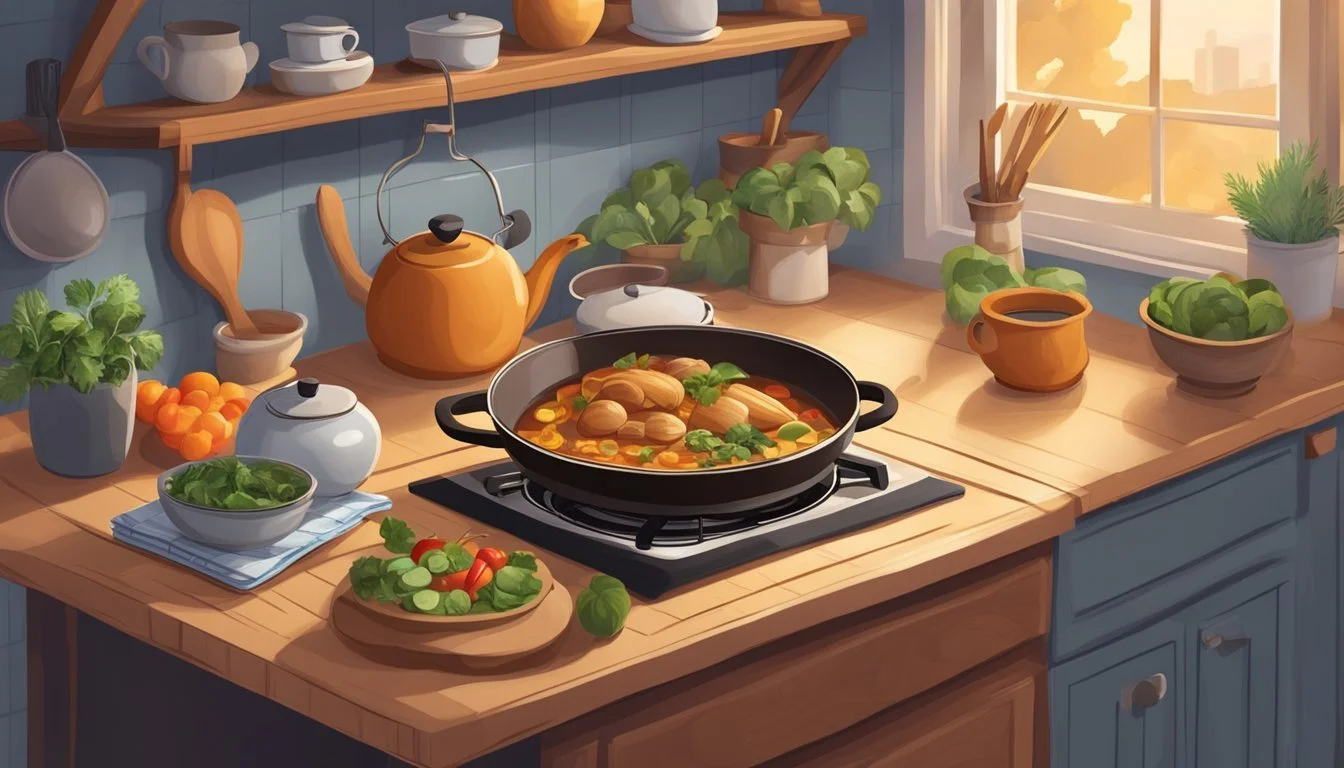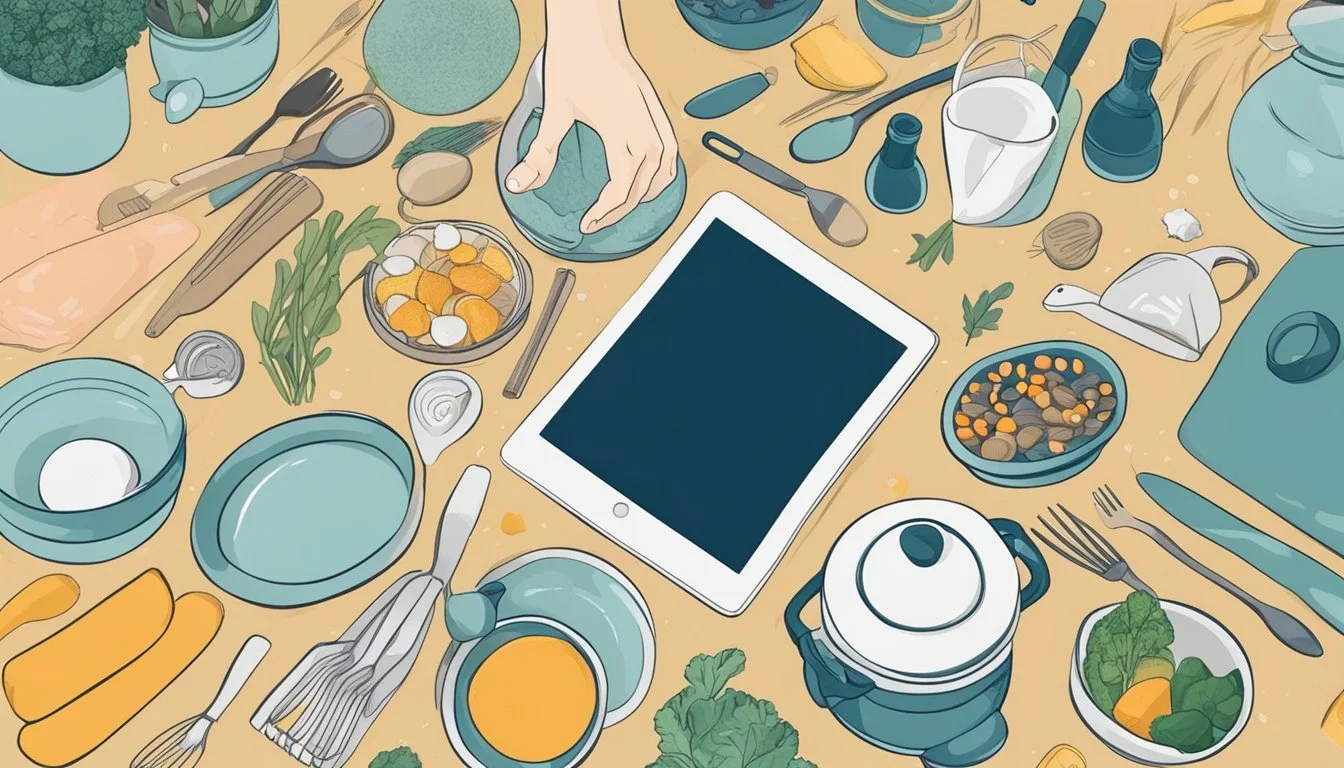How to Cook When You're Struggling with Loneliness
Culinary Therapy for the Solo Diner
Cooking can serve as a therapeutic activity that not only nurtures the body but also the mind. When one grapples with the pangs of loneliness, the kitchen can transform into a place of solace and expression. It allows for a meditative focus on the task at hand, which can alleviate feelings of isolation. By engaging in the process of preparing food, individuals provide care for themselves, highlighting the importance of self-sustenance during solitary times.
The act of cooking can also foster a sense of connection. While it may appear to be a solitary activity, it inherently carries the potential to bring people together, even if asynchronously. Sharing recipes, enjoying the memory of family meals, or planning to distribute dishes to friends and neighbors can create invisible threads of companionship and communal participation.
Moreover, cooking when feeling lonely can be an act of self-love and appreciation. It presents an opportunity to explore personal tastes, learn new skills, and take pride in one's creations. Unlike other activities, cooking results in a tangible reward – a meal that can satisfy and comfort. This process can break the cycle of negative thoughts and redirect energy towards a nurturing and creative endeavor.
Understanding Loneliness and Its Effects
Loneliness is a complex emotional state that carries significant consequences for mental and physical health. It emerges from the perceived deficiency of meaningful social relationships and connections.
Defining Loneliness
Loneliness is the subjective feeling of being alone, regardless of the amount of social contact one has. People feel lonely when they think their relationships are not as extensive or meaningful as they desire. Loneliness is distinguished from solitude, which is the state of being alone without feeling lonely.
The Impact of Loneliness on Mental Health
Loneliness can gravely affect one's mental health. It's associated with an increased risk of depression, worsened anxiety, and heightened stress levels. When individuals feel isolated, it can lead to a cycle where loneliness breeds further withdrawal from social interaction, exacerbating feelings of emotional well-being.
Common mental health impacts include:
Increased risk of depressive disorders
Intensified feelings of anxiety and stress
Decreased emotional well-being and satisfaction with life
Physical Health Risks Associated with Loneliness
The physical health risks that accompany loneliness are just as concerning. Research indicates it's a risk factor for:
Heart disease: Loneliness may lead to increased blood pressure and cholesterol levels, contributing to heart disease.
Stroke: The stress and emotional strain from loneliness could influence stroke incidence.
The body's response to prolonged loneliness can include chronic stress, which in turn affects various health aspects, potentially leading to a compromised immune system and overall greater susceptibility to physical ailments.
Cooking as a Strategy for Combatting Loneliness
In times of loneliness, cooking emerges as a valuable strategy that not only fills the stomach but also the heart. It engages the mind and senses, creating a nourishing experience that extends beyond the kitchen.
Why Cooking Can Improve Well-Being
Cooking can be a powerful activity for enhancing one's well-being. It offers a sense of control when preparing meals, allowing people to choose ingredients and flavors that suit their tastes and nutritional needs. The act of cooking also provides structure to one's day, offering a schedule and tasks that can lead to a sense of accomplishment. By focusing on the present moment during cooking, individuals often experience a reduction in feelings of loneliness.
The Therapeutic Process of Cooking
The process of cooking itself can be therapeutic. The rhythmic nature of chopping, stirring, and sautéing can serve as a meditative practice, reducing stress and increasing mindfulness. Moreover, the kitchen becomes a creative space where experimenting with recipes can boost mood and self-esteem. Sharing meals with others also fosters connections and can transform solitary cooking into an opportunity for social engagement.
Simple Recipes to Get Started
For those seeking a starting point, simple recipes can be the gateway to the culinary world:
Egg Muffins
Ingredients: eggs, spinach, cheese, diced peppers
Instructions: Whisk ingredients, pour into muffin tins, and bake at 350°F for 20 minutes.
Stir-Fry Vegetables with Chicken
Ingredients: diced chicken, mixed vegetables, soy sauce, garlic
Instructions: Cook chicken, add vegetables, stir in soy sauce, and cook until tender.
Pasta with Tomato Sauce
Ingredients: pasta, canned tomatoes, basil, garlic, olive oil
Instructions: Cook pasta, sauté garlic, blend tomatoes, combine with pasta, garnish with basil.
Starting with these straightforward recipes can empower individuals to not only feed themselves but also to relish the joy of cooking, thus taking a significant step toward mitigating feelings of loneliness.
Building Connections Through Food
Cooking and dining play a vital role in fostering relationships and creating a sense of community. Through the act of sharing meals and participating in food-related events, individuals can combat feelings of loneliness by cultivating meaningful connections with family, friends, and the broader community.
Sharing Meals with Others
Inviting individuals to share a meal is one of the simplest yet most profound ways to establish social connections. A family dinner, for example, becomes more than just eating food together; it's a time to engage in conversation, share experiences, and create lasting memories. Similarly, arranging to have lunch or dinner with friends can strengthen bonds and offer a space for support and camaraderie.
For one-on-one connections: Scheduling regular meal times with a friend or family member establishes a routine that can foster a deeper relationship.
For families: Family meals can become a tradition that reinforces the family unit and provides consistent opportunities for family members to connect.
Food-Related Social Events
Hosting or attending food-centered social gatherings broadens one's social network and introduces individuals to new potential connections within their community. Events like potlucks, cooking classes, or neighborhood barbecues encourage interaction among participants and provide a relaxed environment for forming new relationships.
Community events: by participating in local food festivals or farmers’ markets, individuals can engage with their community and even make a contribution, such as volunteering.
Themed meetups: groups can revolve around specific types of cuisines or cooking techniques, offering members a chance to bond over shared culinary interests.
Type of Event Purpose Potential for Connections Potluck dinners Share diverse dishes Meet neighbors and friends of friends Cooking classes Learn skills together Interact with newcomers and aficionados Food festivals Celebrate culinary arts Connect with local vendors and fellow foodies Recipe exchange Swap favorite recipes Build rapport with fellow home cooks
By engaging in these activities, individuals not only enrich their social lives but also contribute to nurturing a vibrant, supportive network conducive to collective well-being.
Incorporating Self-Care into Cooking
Cooking can be a therapeutic activity that nurtures both the body and mind. It allows an individual to engage in an act of self-care, demonstrating self-compassion and love through the food they prepare for themselves.
Mindful Cooking Practices
Mindfulness in the kitchen transforms cooking from a mundane task to a form of meditation. When individuals focus on the present moment, they foster a state of calmness. To practice mindfulness while cooking, one may:
Engage the Senses: Pay close attention to the colors, textures, aromas, and sounds of the ingredients and the cooking process.
Cook Intentionally: Prepare meals deliberately, savoring each step, from chopping vegetables to stirring a sauce.
Express Gratitude: Show appreciation for the ingredients, the ability to cook, and the nourishment provided by the meal.
Boosting Self-Love with Nutritious Meals
Nutrition is a fundamental component of self-care, and choosing to cook nutritious meals is a profound expression of self-love. Meals balanced with essential nutrients affirm one’s commitment to personal health and well-being. Here's a simple structure for constructing a balanced meal:
Select Wholesome Ingredients: Opt for whole foods like fruits, vegetables, whole grains, lean proteins, and healthy fats.
Create Balance: Ensure each meal contains a combination of carbohydrates, fats, and proteins for sustained energy and satiety.
Serve Mindful Portions: Honor the body’s hunger and fullness cues by serving appropriate portion sizes.
Turning Cooking into a Creative Outlet
Cooking can become a significant creative outlet for individuals, especially those combating feelings of loneliness. It offers an expressive platform that combines artistry with practicality, engaging both the mind and senses.
Exploring Artistic Aspects of Cooking
In the pursuit of creativity, one can view cooking as an extension of art. The kitchen serves as their studio, where ingredients become the paint and dishes the canvas. Presentation is key; just as artists carefully arrange shapes and colors, cooks can plate their food thoughtfully, creating visually appealing arrangements that delight the eye. Experimentation with textures and flavors offers endless possibilities akin to mixing different media in art. For example, the crunch of a well-seared crust against the softness of a fluffy biscuit can provide satisfying contrast and depth to a dish.
One can also draw parallels between the methodical process of cooking and sculpting. Both arts require patience and attention to detail—whether one is delicately forming a perfect ravioli or carefully chiseling away at marble.
Finding Inspiration from International Cuisines
Exploring international cuisines introduces cooks to a wide array of techniques and ingredients, offering a rich tapestry of culinary traditions to draw inspiration from. The use of a table enables a concise comparison of various aspects of multiple cuisines:
Cuisine Key Ingredient Typical Technique Unique Characteristic Italian Olive oil Sautéing Emphasis on simplicity Japanese Rice Steaming Balance and umami Mexican Corn Grilling Bold flavors Indian Spices (e.g., turmeric) Frying Complex spice profiles
By incorporating an international palette, cooks can embark on a gastronomic tour, allowing them to escape solitude and connect with different cultures. Preparing a Japanese miso soup or an Indian curry can be more than just a meal; it’s a doorway to understanding and appreciating a culture's soul.
Bringing international elements into one's cooking encourages branching out from comfort zones, thereby nurturing one's hobby of cooking and enabling growth in their culinary creativity.
Embracing Technology to Alleviate Isolation
In a digitally connected world, technology offers unique avenues for individuals grappling with loneliness to engage with others and share their passion for cooking. Leveraging online platforms can transform the solitary act of cooking into a communal and interactive experience.
Cooking Classes and Online Resources
Online Cooking Classes: Individuals can enhance their culinary skills and connect with like-minded food enthusiasts by enrolling in online cooking classes. Platforms such as MasterClass or Udemy offer courses taught by renowned chefs, often including interactive components where participants can ask questions and receive feedback.
Cooking Podcasts: For auditory learners, cooking podcasts present a plethora of cook-along sessions and gastronomic discussions, which can be both informative and comforting. Listening to podcasts while cooking can simulate the company of a friend in the kitchen.
Engaging with Online Communities
Facebook Groups and Forums: Many people join online culinary forums and Facebook groups to share recipes, cooking tips, and food photography. These spaces create a sense of community where individuals can both give and receive support, making the solitary activity of cooking feel more socially connected.
Virtual Cooking Challenges: Engaging in online cooking challenges can provide motivation and a sense of camaraderie. Sites like Reddit's r/Cooking have regular challenges that invite users to cook with specific ingredients or themes and share their creations.
Using Social Media to Share Your Creations
Instagram and Pinterest: Presenting one's culinary creations on platforms like Instagram and Pinterest not only allows for creative expression but also invites feedback and interaction from a global audience. It's a fulfilling way to connect through a shared love of food.
YouTube Channels: Starting a YouTube channel gives individuals a platform to document their cooking journey, teach others, and build a subscriber base. This interactive exchange can lessen feelings of loneliness as creators engage with their viewers.
Expanding Your Support Network
Expanding one's support network is an effective way to combat feelings of loneliness, especially while engaging in solitary activities like cooking. By reaching out and connecting with others, people can forge new relationships and strengthen existing ones, enhancing their social environment and emotional well-being.
Joining Cooking or Hobbyist Clubs
Cooking clubs and hobbyist groups provide an avenue for individuals to meet like-minded people. They can seek clubs locally or through online platforms where members share recipes, techniques, and experiences. Joining these clubs often leads to regular meetups and social gatherings, which foster new relationships and communal support.
Where to find clubs:
Local community centers
Online forums and social media groups
Specialty cooking stores
Reaching Out to Family and Reconnecting with Old Friends
One should not overlook existing relationships such as family and old friends. Reaching out to reconnect can be a step toward rekindling support. Individuals can suggest family gatherings or dinner parties that encourage cooking together, which can strengthen bonds and provide emotional support.
Ways to reconnect:
Schedule regular visits or calls.
Plan cooking-based get-togethers.
Send personal messages or letters to re-establish contact.
Finding Support through Therapy and Counseling
For those in need of more structured support, therapy and counseling can offer professional guidance. A therapist or counselor can help individuals navigate their feelings of loneliness and develop strategies for building and maintaining relationships. They may also suggest community resources such as volunteer opportunities or support groups.
Seeking professional help:
Contact local mental health clinics.
Use online directories to find a therapist.
Look for support groups specifically focusing on cooking or shared interests.
Bridging the Age Divide with Cooking
Cooking can be a powerful connector across generations, creating shared experiences and transferring knowledge and traditions from old to young and vice versa.
Cooking for Different Age Groups
For older adults, cooking can sometimes present challenges due to age-related conditions. They may face difficulties with tasks such as chopping produce or remembering whether they've turned off the oven. In contrast, younger individuals might lack the cooking experience or knowledge of family recipes that their elders possess. It is essential to tailor the cooking activities to the abilities and interests of different age groups while ensuring safety and creating a welcoming environment for learning and participation.
Intergenerational cooking can provide a solution, where each generation brings its strengths to the kitchen. For example, grandchildren might assist with the preparation tasks, like:
Washing and chopping fruits and vegetables - easily handled by the young.
Reading recipes and controlling the cooking process - tasks where the more experienced can guide while still being actively involved.
Family meals, especially those which involve cooking together, are not just about the food. They are about the stories, the teaching moments, and the shared experience.
Intergenerational Cooking Experiences
An intergenerational kitchen fosters an environment where different age groups can learn from each other. Grandparents might share heirloom recipes, tricks for kneading dough, or secrets to perfect gravy. Grandchildren can bring new culinary trends or innovative cooking methods into the mix.
Here are some ways to enhance these experiences:
Recipe Swapping - Younger family members introduce contemporary recipes, while older members contribute traditional ones.
Cooking Stations - Designate areas where different tasks can be performed, catering to various skill levels and abilities.
By this exchange, not only are family bonds strengthened, but a bridge is built between the different worlds that each generation inhabits. This process enriches the family’s culinary culture and ensures the continuation of heritage and the creation of new traditions.
Harnessing Nature and the Outdoors
When individuals are facing loneliness, engaging in outdoor activities, particularly cooking and sharing meals, can have significant mental and physical health benefits. This section discusses how one can utilize nature through outdoor cooking and picnics as well as gatherings in natural settings to not only create delicious meals but also build connections and improve wellbeing.
Outdoor Cooking and Picnics
Outdoor cooking, such as grilling on a grate or preparing food with hot stones, provides a great way to enjoy nature and improve one's mood. A picnic in a serene park setting allows individuals to soak in the benefits of the outdoors while engaging in a fulfilling activity. Some steps to consider:
Choose a suitable location: Select a park or an outdoor area that allows cooking and has adequate facilities.
Prepare the equipment: Bring portable cooking gear or use available natural materials, such as flat rocks for a cooking surface.
Safety first: Always use heat-resistant gloves and long-handled utensils to handle food safely.
Gatherings in Parks and Nature
Gatherings in parks offer an excellent opportunity for social interaction, which is crucial in combating feelings of loneliness. Parks serve as communal spaces where people can participate in group exercises or simply enjoy the benefits of being outdoors among others. Here are a few tips:
Organize group exercises: Initiate a yoga session or a light workout to encourage physical health and social engagement.
Plan a community meal: Invite neighbors or friends for a picnic or a potluck, fostering connections and a sense of community.
These activities often lead to regular meetups, providing structure and ongoing support, contributing to improved mental and physical well-being.
Post-Pandemic Reconnection Strategies
In the wake of the COVID-19 pandemic, individuals face the challenge of rebuilding their social networks and discovering new ways to engage with others. These strategies emphasize the safe and meaningful restoration of interpersonal connections through shared interests like cooking.
Rebuilding Social Networks After Isolation
Many found their social networks diminished during the pandemic, and now face the task of nurturing these connections again. One can start by reaching out to friends and family to rekindle relationships. Hosting small events or joining local community groups can also be beneficial. Online platforms offer a means to connect with new people who share similar interests, such as cooking forums or virtual culinary book clubs.
Tips for Rebuilding Social Networks:
Reconnect with old friends via phone calls or social media.
Join interest-based groups or clubs.
Attend community events or workshops.
Volunteer for community service to meet like-minded individuals.
Hosting Post-Pandemic Cooking Gatherings
Cooking gatherings can serve as an excellent method for people to reconnect after experiencing isolation due to the pandemic. When hosting a cooking event, it's important to create a comfortable and safe environment for all guests. Ensuring availability of hand sanitizers and open spaces can reassuringly align with health guidelines. Themed cooking nights or potluck dinners encourage participation and conversation, enabling guests to share their culinary experiences and recipes.
Ideas for Cooking Gatherings:
Potluck dinners where each guest brings a dish.
Cooking competitions with a friendly theme.
Recipe swap events to share and discover new dishes.
Outdoor barbeques to make the most of open spaces.
These gatherings not only foster personal bonds but also reinforce social support systems that might have weakened during the pandemic. By engaging in shared activities like cooking, individuals can rebuild a sense of community and combat feelings of loneliness.
Strategies for Overcoming Cooking-Related Anxiety
Cooking-related anxiety can manifest as a fear of the cooking process or stress about the outcome of a meal. Overcoming this anxiety involves establishing coping mechanisms for the stress and seeking professional help if necessary.
Coping Mechanisms for Cooking Stress
Individuals may alleviate cooking-related stress by organizing their cooking space, planning meals, and simplifying recipes. It's beneficial to start with straightforward dishes that require minimal steps or ingredients. Practical strategies include:
Preparation: Prepare ingredients and cookware ahead of time.
Simple recipes: Begin with basic recipes that build confidence.
Learning: Watch online tutorials for skill development.
Mindfulness: Practice cooking as a mindful activity to stay present.
For those experiencing negative emotions like shame or guilt associated with cooking, reframing these feelings can help. One might acknowledge that perfection is not the goal, but rather the act of nourishment and self-care.
Professional Help for Cooking Anxiety
For severe anxiety, seeking professional help may be necessary. A licensed therapist can assist through:
Cognitive Behavioral Therapy (CBT): This can help change negative thought patterns about cooking.
Exposure Therapy: Gradual exposure to cooking can desensitize individuals to their anxiety.
Support Groups: Sharing experiences with others who have similar struggles.
Exploring these therapeutic options can provide relief from stress and negative feelings linked to cooking. Assistance from a mental health professional can also address deeper issues of anxiety, guiding individuals towards a more positive cooking experience.
Addressing the Stigma of Seeking Help
The stigma surrounding loneliness can often deter individuals from seeking support. It's important to recognize that loneliness is a common experience and seeking help is a positive step towards wellbeing.
Overcoming the Shame of Loneliness
Loneliness carries an undeserved shame, yet it's a feeling that countless people experience. Overcoming this shame involves acknowledging that loneliness is not a personal failing but a human condition. Individuals should know that reaching out for help is a sign of strength and self-awareness. Pursuing cooking as a shared activity can be a valuable step in connecting with others and combating feelings of isolation.
Embracing Community and Volunteer Resources
Engaging with community resources can provide supportive networks that alleviate loneliness. Local organizations often offer cooking classes or food-related events that foster connections. Volunteer opportunities, particularly those involving food preparation or distribution, can also create a sense of purpose and belonging. By contributing to the needs of others, one can find companionship and build meaningful relationships within the community.
Conclusion
Cooking during times of loneliness can serve as a beacon of hope for many. It offers not only a distraction but also a way to foster self-compassion and self-care. A nutritious meal is a fundamental form of nurturing oneself, a practice that is essential when combating feelings of isolation.
By transforming the kitchen into a place of creativity and comfort, individuals can find motivation to explore new recipes and culinary challenges. The act of cooking itself can become a guide to a healthier mindset, encouraging routine and a sense of achievement.
Moreover, the kitchen can be an avenue for connection. Inviting friends or family to share a meal, even virtually, allows for communal experiences and listening to others, thus lessening the heaviness of solitude. For those who live alone, engaging with cooking shows or online culinary communities can provide a sense of belonging and interaction.
In conclusion, utilising the art of cooking as a therapeutic tool opens up opportunities for both self-improvement and social connection. It is a step towards embracing solitude as a period of personal growth and reflection, teaching individuals that even in the quietest moments, hope and resilience can be found.












